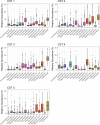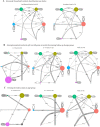The respiratory microbiome and susceptibility to influenza virus infection
- PMID: 30625134
- PMCID: PMC6326417
- DOI: 10.1371/journal.pone.0207898
The respiratory microbiome and susceptibility to influenza virus infection
Abstract
Influenza is a major cause of morbidity and mortality worldwide. However, vaccine effectiveness has been low to moderate in recent years and vaccine coverage remains low, especially in low- and middle-income countries. Supplementary methods of prevention should be explored to reduce the high burden of influenza. A potential target is the respiratory tract microbiome, complex microbial communities which envelop the respiratory epithelium and play an important role in shaping host immunity. Using a household transmission study, we examined whether the nose/throat microbiota was associated with influenza susceptibility among participants exposed to influenza virus in the household. Further, we characterized changes in the nose/throat microbiota to explore whether community stability was influenced by influenza virus infection. Using a generalized linear mixed effects model, we found a nasal/oropharyngeal community state type (CST) associated with decreased susceptibility to influenza. The CST was rare and transitory among young children but a prevalent and stable CST among adults. Using boosting and linear mixed effects models, we found associations between the nose/throat microbiota and influenza also existed at the taxa level, specifically with the relative abundance of Alloprevotella, Prevotella, and Bacteroides oligotypes. We found high rates of change between bacterial community states among both secondary cases and household contacts who were not infected during follow up. Further work is needed to separate the effect of influenza virus infection from the considerable short-term changes that occur even in the absence of virus. Lastly, age was strongly associated with susceptibility to influenza and the nose/throat bacterial community structure. Although additional studies are needed to determine causality, our results suggest the nose/throat microbiome may be a potential target for reducing the burden of influenza.
Conflict of interest statement
The authors have declared that no competing interests exist.
Figures






References
-
- World Health Organization. Influenza. In: Immunization, vaccines and biologicals: influenza [Internet]. [cited 17 Feb 2017]. Available: http://www.who.int/immunization/topics/influenza/en/
-
- WHO Global Influenza Programme. Seasonal Influenza Vaccine Use in Low and Middle Income Countries in the Tropics and Subtropics A systematic review. [Internet]. Geneva, Switzerland: World Health Organization; 2015. January Available: http://apps.who.int/iris/bitstream/10665/188785/1/9789241565097_eng.pdf
Publication types
MeSH terms
Grants and funding
LinkOut - more resources
Full Text Sources
Medical

